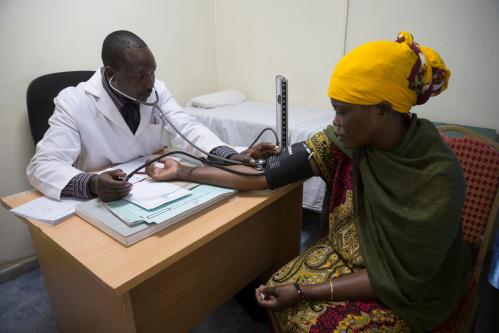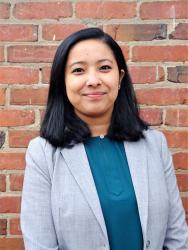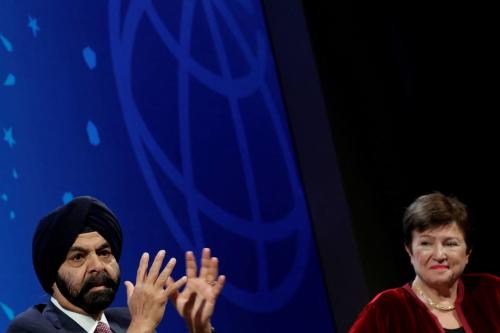This blog features insights from the recent Stories from Africa seminar series at Duke University.
The Sustainable Development Goal (SDG) health targets are extremely ambitious. They call for ending the epidemics of AIDS, tuberculosis, malaria and neglected tropical diseases, and preventable deaths of newborns and children below 5 years of age by 2030. Achieving these targets will require large sums of money. Karin Stenberg and colleagues estimate that among 67 low-income countries (LICs) and middle-income countries (MICs)—representing 95 percent of the population of all LICs and MICs—the annual financing gap to reach the SDG health targets is more than $370 billion.
About half of these countries are in sub-Saharan Africa, where the health financing gap is particularly acute. Africa makes up 16 percent of the world population and carries 23 percent of the global disease burden, yet it accounted for just 1 percent of total global health expenditures in 2015. In per capita terms, the rest of the world spends 10 times more on health care than Africa.
out-of-pocket payments—a big burden
Although 44 percent of current health expenditures (meaning “the final consumption of health goods and services”) in Africa was financed through domestic government funds in 2016, more than 37 percent of all of Africa’s health spending comes from out-of-pocket payments. This burden has significant implications at the household level. For example, at least 11 percent of Africans experience catastrophic spending for health care every year, while as many as 38 percent delay or forgo health care due to high costs. If the ambitious SDGs are to be reached in Africa, significant efforts must be made to change the current spending environment.
Increased donor funds will not be enough to close this financing gap. External support for health is a tiny share of global health spending—just 0.2 percent of health expenditures in 2016 and, even in Africa, just 9 percent. Development assistance for health has been more or less stagnant since around 2008 (i.e., in the wake of the global financial crisis). Although emerging donors such as China are becoming increasingly engaged in health assistance in Africa, these additional funds from new donors are unlikely to be significant enough to be a game changer.
When donors leave
Understandably, many donors “graduate” countries from their health programs when they cross an eligibility threshold. If donor funding is small, it shouldn’t really matter. But it does; though donor financing pales in comparison with other sources of health financing in Africa, donors often fund “big-ticket items” such as childhood vaccination programs, and HIV, tuberculosis, and malaria control. In Tanzania, for example, 98 percent of HIV/AIDS funding came from external sources. Losing donor help could prevent Tanzania from achieving the health-related SDGs. It would derail the progress towards the 90-90-90 HIV treatment targets.
The Addis Ababa Action Agenda highlighted the need for the mobilization of private-sector finance and domestic public resources. Yet it is not clear how much of the financing gap can actually be closed by mobilizing domestic resources alone. Recent research has suggested that domestic resource mobilization for health through taxation is a viable alternative. However, when asked directly, 46 percent of respondents in 36 African countries opposed paying additional taxes or user fees to improve spending on public health care. This is not surprising considering the high level of out-of-pocket payments in Africa.
Another source of financing for the health SDGs is a higher share for health care in domestic budgets. But most countries are moving far too slowly. In 2001, African Union countries pledged to spend at least 15 percent of their annual national budgets on health (the Abuja declaration). Ten years later, an analysis by the WHO found that only one country (Tanzania) had achieved the target and 11 countries had actually cut the share of government expenditures going to health. To address financing shortfalls, leaders met on the sidelines of the recent African Union Summit in February 2019 to “launch a new initiative aimed at increasing commitments for health, improving the impact of spending and ensuring the achievement of universal health coverage.”
Doing more with less
We think that progress towards achieving the SDGs for health can still be made in Africa with the adoption of four straightforward—i.e., simple, not easy—steps to encourage efficiency.
1. Keep moving towards pooled financing of health care. Since out-of-pocket payments account for 31 percent of health care financing, pooling these resources could allow strategic purchasing of health services. Universal health coverage (UHC) initiatives provide opportunities to pool, and it is encouraging to see that several countries are pursuing UHC goals. Policymakers in Africa can also find solace in the fact that there is a high correlation between an individual’s willingness to pay more taxes or out-of-pocket payments for health care, and that individual’s perception of the government’s efforts to improve health care provision. A government that shows citizens that it is spending health care funds wisely will be able to raise more funds for health care.
2. Encourage donors to be more innovative and strategic. Funding models that allow governments to reallocate money away from health care should be discouraged while models that encourage domestic resource mobilization and prioritization of health should be encouraged. An example of health prioritization is the recent $75 million financing agreement between the Nigerian Government and the Bill & Melinda Gates Foundation to strengthen Nigeria’s Basic Health Care Provision Fund.
Donors should also be persuaded to be more flexible with their graduation/exit criteria. Recent studies show that most poor people in the world now live in middle-income economies, not low-income countries. Ironically, middle-income countries face imminent loss of donor funds because of their recent history of economic growth. If donors cut funding and middle-income countries are unable to close the gap in financing, then the SDG pledge to “Leave No One Behind” would sound hollow. A recent example is the extension of Gavi’s support to Nigeria for another 10 years—contingent on the Nigerian government fulfilling commitments to invest in its vaccines during the 10-year period.
3. Adopt systems that foster innovation and continuous learning in financing and delivery. Potential opportunities include using technology to create alternative and more efficient care delivery models, fostering learning across countries through collaborative learning systems like the African Collaborative for Health Financing Solutions, and the adoption of homegrown solutions for health care delivery problems. This was the topic of a seminar in the Stories from Africa series at Duke University; the insights are published here.
4. Get serious about addressing waste and leakages. The 2010 World Health Report suggests that 20 to 40 percent of all health care resources are lost to inefficiencies in the system. Areas with potential for results include: 1) medicines and health technologies, where increased use of generics and reductions in counterfeits can help a lot, 2) human resources for health, where tackling absenteeism and promoting task-shifting have been shown to work, and 3) corruption and fraud, where policies to improve transparency and regulation could help.
The SDG era requires novel approaches. The disease burden is evolving, placing a growing weight of noncommunicable diseases on top of the unfinished infectious disease agenda. Development assistance for health is no longer increasing at the record rates seen in the Millennium Development Goal period. Many countries are finding themselves ineligible for traditional forms of foreign assistance. Policymakers in Africa will have to respond by continually asking how to buy more health for every dollar they spend. The answers they come up with could shift their countries—and the continent—onto trajectories consistent with the ambition of the health SDGs.









Commentary
Closing Africa’s health financing gap
March 1, 2019